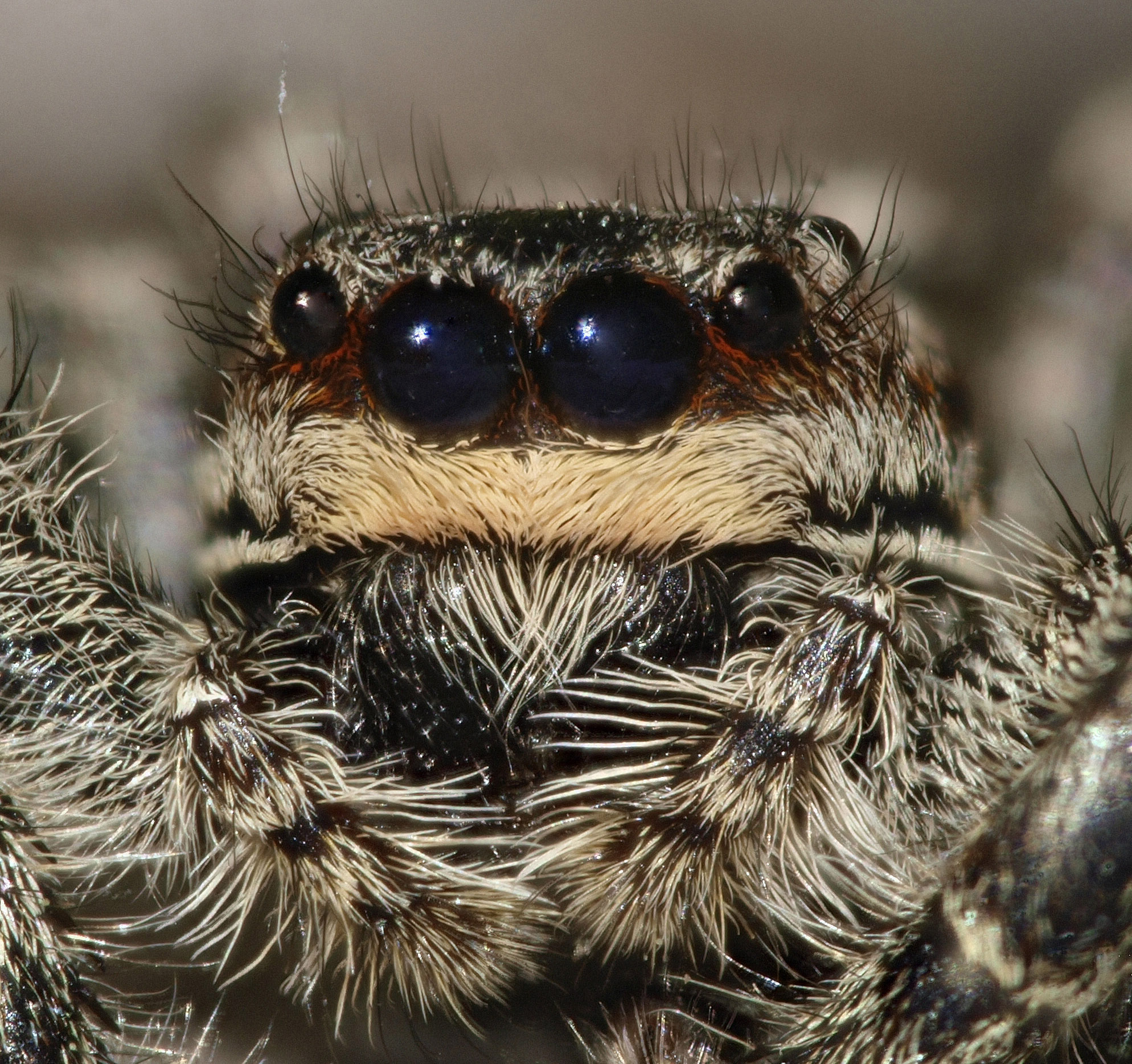|
Marpissa Muscosa
''Marpissa muscosa'' is a species of jumping spider. On average, females have body length ranging from 7.5–14mm, whereas males have a body length ranging from 6–8.1mm. Both sexes are coloured grey to brown. The whole spider has a furry appearance and is flattened in shape. The species builds a kind of nest under the bark of dead trees. Up to 100 of these nests can occur side by side. As other species of ''Marpissa'' spiders, it demonstrates a social hierarchy: weaker animals will acknowledge their inferiority by strutting their front legs and slowly retreating from the scene. Early environmental conditions shape personality types in the developing spiders.Jannis Liedtke, Daniel Redekop, Jutta M. Schneider, Wiebke Schuett: ''Early environmental conditions shape personality types in a jumping spider.'' In: Ann V. Hedrick: ''The Development of Animal Personality'', Frontiers Research Topics, Frontiers Media SA, vol. 3, Dec 2015, article 134, , , . Distribution ''Marpissa musco ... [...More Info...] [...Related Items...] OR: [Wikipedia] [Google] [Baidu] |
Carl Alexander Clerck
Carl Alexander Clerck (1709 – 22 July 1765) was a Sweden, Swedish entomologist and arachnology, arachnologist. Clerck came from a family in the petty Swedish nobility, nobility and entered the University of Uppsala in 1726. Little is known of his studies; although a contemporary of Carl Linnaeus, Linnaeus, it is unknown whether he had any contact with him during his time in Uppsala. His limited means forced him to leave university early and enter into government service, later ending up working in the administration of the City of Stockholm. His interest in natural history appears to have come at a more mature age, influenced by a lecture of Linnaeus he attended in Stockholm in 1739. In the following years he collected and categorized many spiders, published together with more general observations on the morphology and behaviour of spiders, in his ''Svenska Spindlar'' ("Swedish spiders", 1757, also known by its Latin subtitle, ''Aranei Suecici''). He also started the publication ... [...More Info...] [...Related Items...] OR: [Wikipedia] [Google] [Baidu] |
Svenska Spindlar
The book ' or ' (Swedish and Latin, respectively, for "Swedish spiders") is one of the major works of the Swedish arachnologist and entomologist Carl Alexander Clerck and was first published in Stockholm in the year 1757. It was the first comprehensive book on the spiders of Sweden and one of the first regional monographs of a group of animals worldwide. The full title of the work is '' – '', ("Swedish spiders into their main genera separated, and as sixty and a few particular species described and with illuminated figures illustrated") and included 162 pages of text (eight pages were unpaginated) and six colour plates. It was published in Swedish, with a Latin translation printed in a slightly smaller font below the Swedish text. Clerck described in detail 67 species of Swedish spiders, and for the first time in a zoological work consistently applied binomial nomenclature as proposed by Carl Linnaeus. Linnaeus had originally invented this system for botanical names in his 1753 ... [...More Info...] [...Related Items...] OR: [Wikipedia] [Google] [Baidu] |
Species
In biology, a species is the basic unit of classification and a taxonomic rank of an organism, as well as a unit of biodiversity. A species is often defined as the largest group of organisms in which any two individuals of the appropriate sexes or mating types can produce fertile offspring, typically by sexual reproduction. Other ways of defining species include their karyotype, DNA sequence, morphology, behaviour or ecological niche. In addition, paleontologists use the concept of the chronospecies since fossil reproduction cannot be examined. The most recent rigorous estimate for the total number of species of eukaryotes is between 8 and 8.7 million. However, only about 14% of these had been described by 2011. All species (except viruses) are given a two-part name, a "binomial". The first part of a binomial is the genus to which the species belongs. The second part is called the specific name or the specific epithet (in botanical nomenclature, also sometimes i ... [...More Info...] [...Related Items...] OR: [Wikipedia] [Google] [Baidu] |
Jumping Spider
Jumping spiders are a group of spiders that constitute the family (biology), family Salticidae. As of 2019, this family contained over 600 described genera and over 6,000 described species, making it the largest family of spiders at 13% of all species. Jumping spiders have some of the best vision among arthropods and use it in courtship, hunting, and navigation. Although they normally move unobtrusively and fairly slowly, most species are capable of very agile jumps, notably when hunting, but sometimes in response to sudden threats or crossing long gaps. Both their book lungs and Invertebrate trachea, tracheal system are well-developed, and they use both systems (bimodal breathing). Jumping spiders are generally recognized by their eye pattern. All jumping spiders have four pairs of eyes, with the Anatomical terms of location, anterior median pair being particularly large. Distinguishing characteristics Jumping spiders are among the easiest to distinguish from similar spider f ... [...More Info...] [...Related Items...] OR: [Wikipedia] [Google] [Baidu] |
Palaearctic
The Palearctic or Palaearctic is the largest of the eight biogeographic realms of the Earth. It stretches across all of Eurasia north of the foothills of the Himalayas, and North Africa. The realm consists of several bioregions: the Euro-Siberian region; the Mediterranean Basin; the Sahara and Arabian Deserts; and Western, Central and East Asia. The Palaearctic realm also has numerous rivers and lakes, forming several freshwater ecoregions. The term 'Palearctic' was first used in the 19th century, and is still in use as the basis for zoogeographic classification. History In an 1858 paper for the ''Proceedings of the Linnean Society'', British zoologist Philip Sclater first identified six terrestrial zoogeographic realms of the world: Palaearctic, Aethiopian/Afrotropic, Indian/Indomalayan, Australasian, Nearctic, and Neotropical. The six indicated general groupings of fauna, based on shared biogeography and large-scale geographic barriers to migration. Alfred Wallace ad ... [...More Info...] [...Related Items...] OR: [Wikipedia] [Google] [Baidu] |
Salticidae
Jumping spiders are a group of spiders that constitute the family Salticidae. As of 2019, this family contained over 600 described genera and over 6,000 described species, making it the largest family of spiders at 13% of all species. Jumping spiders have some of the best vision among arthropods and use it in courtship, hunting, and navigation. Although they normally move unobtrusively and fairly slowly, most species are capable of very agile jumps, notably when hunting, but sometimes in response to sudden threats or crossing long gaps. Both their book lungs and tracheal system are well-developed, and they use both systems (bimodal breathing). Jumping spiders are generally recognized by their eye pattern. All jumping spiders have four pairs of eyes, with the anterior median pair being particularly large. Distinguishing characteristics Jumping spiders are among the easiest to distinguish from similar spider families because of the shape of the cephalothorax and their eye pa ... [...More Info...] [...Related Items...] OR: [Wikipedia] [Google] [Baidu] |
Spiders Of Europe
Spiders ( order Araneae) are air-breathing arthropods that have eight legs, chelicerae with fangs generally able to inject venom, and spinnerets that extrude silk. They are the largest order of arachnids and rank seventh in total species diversity among all orders of organisms. Spiders are found worldwide on every continent except for Antarctica, and have become established in nearly every land habitat. , 50,356 spider species in 132 families have been recorded by taxonomists. However, there has been debate among scientists about how families should be classified, with over 20 different classifications proposed since 1900. Anatomically, spiders (as with all arachnids) differ from other arthropods in that the usual body segments are fused into two tagmata, the cephalothorax or prosoma, and the opisthosoma, or abdomen, and joined by a small, cylindrical pedicel, however, as there is currently neither paleontological nor embryological evidence that spiders ever had a separate t ... [...More Info...] [...Related Items...] OR: [Wikipedia] [Google] [Baidu] |
Spiders Described In 1757
Spiders ( order Araneae) are air-breathing arthropods that have eight legs, chelicerae with fangs generally able to inject venom, and spinnerets that extrude silk. They are the largest order of arachnids and rank seventh in total species diversity among all orders of organisms. Spiders are found worldwide on every continent except for Antarctica, and have become established in nearly every land habitat. , 50,356 spider species in 132 families have been recorded by taxonomists. However, there has been debate among scientists about how families should be classified, with over 20 different classifications proposed since 1900. Anatomically, spiders (as with all arachnids) differ from other arthropods in that the usual body segments are fused into two tagmata, the cephalothorax or prosoma, and the opisthosoma, or abdomen, and joined by a small, cylindrical pedicel, however, as there is currently neither paleontological nor embryological evidence that spiders ever had a separate t ... [...More Info...] [...Related Items...] OR: [Wikipedia] [Google] [Baidu] |
Taxa Named By Carl Alexander Clerck
In biology, a taxon (back-formation from ''taxonomy''; plural taxa) is a group of one or more populations of an organism or organisms seen by taxonomists to form a unit. Although neither is required, a taxon is usually known by a particular name and given a particular ranking, especially if and when it is accepted or becomes established. It is very common, however, for taxonomists to remain at odds over what belongs to a taxon and the criteria used for inclusion. If a taxon is given a formal scientific name, its use is then governed by one of the nomenclature codes specifying which scientific name is correct for a particular grouping. Initial attempts at classifying and ordering organisms (plants and animals) were set forth in Carl Linnaeus's system in '' Systema Naturae'', 10th edition (1758), as well as an unpublished work by Bernard and Antoine Laurent de Jussieu. The idea of a unit-based system of biological classification was first made widely available in 1805 in the i ... [...More Info...] [...Related Items...] OR: [Wikipedia] [Google] [Baidu] |






